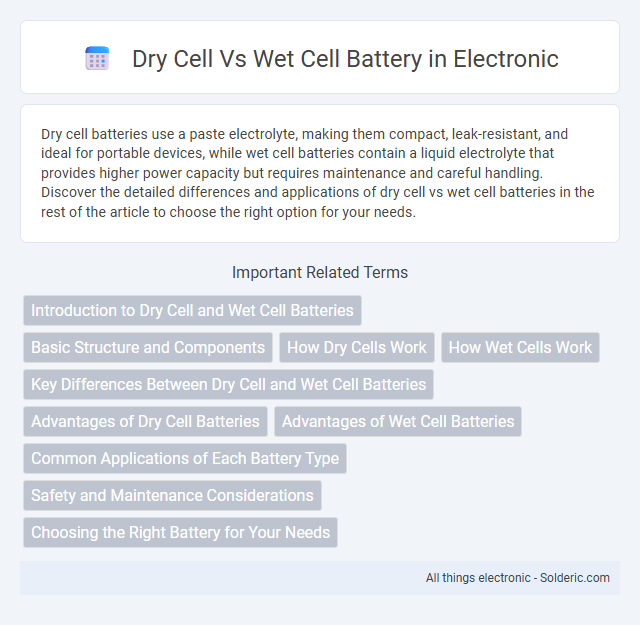Dry cell batteries use a paste electrolyte, making them compact, leak-resistant, and ideal for portable devices, while wet cell batteries contain a liquid electrolyte that provides higher power capacity but requires maintenance and careful handling. Discover the detailed differences and applications of dry cell vs wet cell batteries in the rest of the article to choose the right option for your needs.
Comparison Table
| Feature | Dry Cell Battery | Wet Cell Battery |
|---|---|---|
| Electrolyte | Paste or solid | Liquid solution |
| Leakage Risk | Low | High |
| Portability | High | Low |
| Maintenance | Low to none | Requires regular maintenance |
| Common Uses | Portable electronics, remote controls | Automobiles, backup power systems |
| Voltage Output | Typically 1.5V (e.g., AA cell) | Typically 2V per cell (e.g., lead-acid battery) |
| Durability | Moderate | High |
| Examples | Alkaline, Zinc-carbon batteries | Lead-acid, Ni-Cd batteries |
Introduction to Dry Cell and Wet Cell Batteries
Dry cell batteries use a paste electrolyte, making them portable and leak-resistant, ideal for everyday devices like flashlights and remote controls. Wet cell batteries contain a liquid electrolyte, offering higher capacity and power, commonly found in automotive batteries and backup power systems. Both types convert chemical energy into electrical energy but differ in construction, maintenance, and typical applications.
Basic Structure and Components
Dry cell batteries consist of a zinc anode, a carbon cathode, and an electrolyte paste, which prevents leakage and allows for portability. Wet cell batteries contain two electrodes immersed in a liquid electrolyte, typically sulfuric acid in lead-acid batteries, enabling higher current output but requiring maintenance. The rigid casing of dry cells contrasts with the sealed or vented containers of wet cells, reflecting their structural differences and usage conditions.
How Dry Cells Work
Dry cells generate electrical energy through chemical reactions between the anode, typically zinc, and the cathode, often manganese dioxide, separated by an electrolyte paste. The electrolyte facilitates ion flow without free liquid, enabling compact and leak-resistant construction ideal for portable devices. During discharge, electrons flow from the anode to the cathode through an external circuit, producing usable electrical power.
How Wet Cells Work
Wet cells operate by using a liquid electrolyte, typically a solution of sulfuric acid and water, to facilitate the chemical reaction between the electrodes. The liquid electrolyte allows ions to move freely between the anode and cathode, generating electrical energy through oxidation-reduction reactions. Your understanding of wet cell batteries is key to recognizing their common use in automotive starters and industrial applications where high current output is required.
Key Differences Between Dry Cell and Wet Cell Batteries
Dry cell batteries contain a paste electrolyte, making them leak-resistant and suitable for portable devices, while wet cell batteries use liquid electrolytes, often resulting in higher energy capacity but increased maintenance. Dry cells are sealed and commonly found in household items like remote controls and flashlights, whereas wet cells are typically used in automotive and industrial applications due to their ability to deliver high surge currents. Understanding these key differences helps you choose the right battery type for your specific power needs and device requirements.
Advantages of Dry Cell Batteries
Dry cell batteries offer several advantages, including compact size, portability, and leak resistance, making them ideal for use in portable electronic devices. Their sealed design prevents electrolyte spillage, enhancing safety and reducing maintenance requirements compared to wet cell batteries. Furthermore, dry cells provide reliable performance in various orientations and environments, contributing to their widespread application in consumer electronics.
Advantages of Wet Cell Batteries
Wet cell batteries offer higher energy capacity and longer service life compared to dry cell batteries, making them ideal for applications requiring sustained power output. They provide superior rechargeability and better heat dissipation, which enhances performance in automotive and industrial uses. Your choice of a wet cell battery ensures reliable, cost-effective power for heavy-duty equipment and vehicles.
Common Applications of Each Battery Type
Dry cell batteries are commonly used in portable electronic devices such as flashlights, remote controls, and clocks due to their compact size and sealed design that prevents leakage. Wet cell batteries, often found in automotive starters, backup power supplies, and industrial equipment, provide higher power output and are preferred for applications requiring sustained energy delivery. Your choice between dry cell and wet cell batteries should align with the specific power demands and environmental conditions of your device.
Safety and Maintenance Considerations
Dry cell batteries offer enhanced safety due to their sealed design, which minimizes the risk of acid leaks and corrosion, making them suitable for portable devices and general household use. In contrast, wet cell batteries contain liquid electrolytes that require regular maintenance, including electrolyte level checks and potential spill management, posing higher safety risks and necessitating cautious handling. Proper maintenance of wet cells ensures longevity but demands adherence to safety protocols to prevent acid exposure and equipment damage.
Choosing the Right Battery for Your Needs
Dry cell batteries offer portability and leak resistance, making them ideal for small electronic devices and everyday use, while wet cell batteries provide higher capacity and longer life, suitable for automotive and backup power applications. You should evaluate factors such as energy density, maintenance requirements, and device compatibility when choosing the right battery for your needs. Considering these aspects ensures optimal performance and longevity based on your specific usage conditions.
Dry cell vs Wet cell battery Infographic

 solderic.com
solderic.com